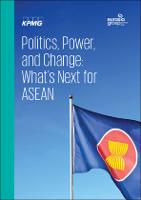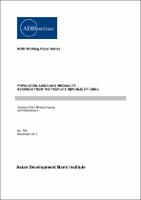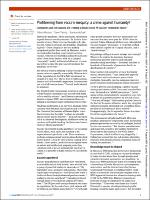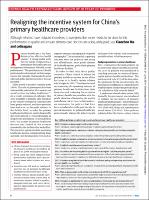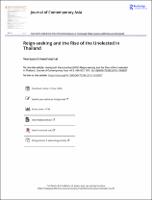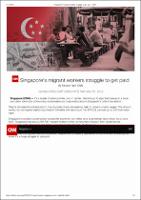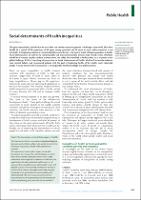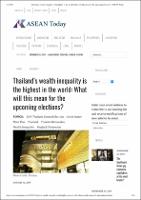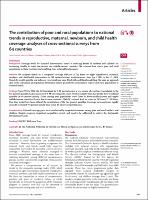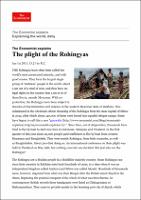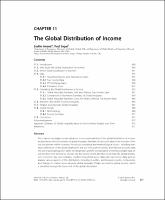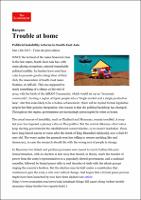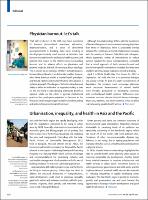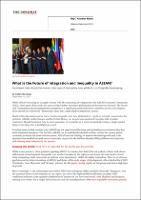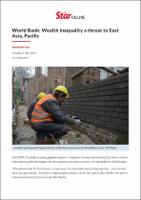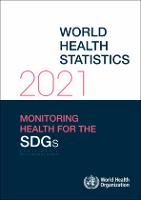Browsing 1.03.02 Economic, Social & Political Context by Title
Now showing items 40-55 of 55
-
Politics, Power, and Change
(KPMG)
There are 10 varied and challenging national storylines unfolding in ASEAN – and businesses need to join these conversations. Juggling the many demands of an increasingly complex stakeholder universe – from consumers to politicians, regulators to society at large – will require an understanding of the wide array of domestic and regional political risks in ASEAN. While there are some challenges that are common to many countries in ASEAN, the level of risk and trend direction vary. There are several questions on geo-strategy in the region: Will ... -
Population Aging and Inequality: Evidence from the People’s Republic of China
Population aging has significant economic and social costs, and this paper studies its impacts on inequality, both theoretically and empirically. First, we build a two-period overlapping-generation model with an uncertain lifetime and find that population aging has the overall effect of increasing income and consumption inequality within the society. For the empirical analysis, we use household data from the China Health and Nutrition Survey to assess the age effect on income and consumption inequality in the People’s Republic of China and confirm ... -
Profiteering from vaccine inequity: a crime against humanity?
(BMJ, 2021-08-16) -
Realigning the incentive system for China’s primary healthcare providers
(BMJ, 2019-06-21) -
Reign-seeking and the Rise of the Unelected in Thailand
(Journal of Contemporary Asia, 2016)
This article develops the concept of “reign-seeking” to capture the unprecedented collective action of the Thai professional and official elite prior to the 2014 military coup and the establishment of a military regime. It argues that this phenomenon reflects broad and deep political dynamics, for which the dominant scholarship on authoritarianism and Thai politics cannot adequately explain. The changing incentives of these supposedly non-partisan actors are interwoven with neo-liberal governance reform driven by a desire for depoliticisation and ... -
Singapore's migrant workers struggle to get paid
(CNN, 2018) -
Social determinants of health inequalities
(The Lancet, 2005)
The gross inequalities in health that we see within and between countries present a challenge to the world. That there should be a spread of life expectancy of 48 years among countries and 20 years or more within countries is not inevitable. A burgeoning volume of research identifies social factors at the root of much of these inequalities in health. Social determinants are relevant to communicable and non-communicable disease alike. Health status, therefore, should be of concern to policy makers in every sector, not solely those involved in ... -
Thailand’s wealth inequality is the highest in the world: What will this mean for the upcoming elections?
(United Nation ESCAP, 2019-01-16) -
The contribution of poor and rural populations to national trends in reproductive, maternal, newborn, and child health coverage: analyses of cross-sectional surveys from 64 countries
(The Lancet Global Health, 2017)
Background Coverage levels for essential interventions aimed at reducing deaths of mothers and children are increasing steadily in most low-income and middle-income countries. We assessed how much poor and rural populations in these countries are benefiting from national-level progress. -
The Economist explains_ The plight of the Rohingyas
(The Economist, 2015) -
The Global Distribution of Income
(Elsevier, 2015)
This chapter investigates recent advances in our understanding of the global distribution of income, and produces the first estimates of global inequality that take into account data on the incomes of the top one percent within countries. We discuss conceptual and methodological issues – including alternative definitions of the global distribution, the use of household surveys and national accounts data, the use of purchasing power parity exchange rates, and the incorporation of recently available data on top incomes from income tax records. We ... -
Trouble at home: Political Instability Southeast Asia
(The Economist, 2015) -
What is the Future of Integration and Inequality in ASEAN?
(the Diplomat, 2017-09-15) -
World Bank: Wealth inequality a threat to East Asia, Pacific
(the Star Online, 2017-12-04) -
World health statistics 2021: monitoring health for the SDGs, sustainable development goals
(World Health Organization, 2021)
WHO’s World health statistics report 2021 presents the latest data for more than 50 health-related indicators for the Sustainable Development Goals and WHO’s “Triple Billion” targets. It finds an overall increase in global life expectancy and healthy life expectancy at birth as a result of improvements in several communicable diseases, maternal, perinatal and nutritional conditions, noncommunicable diseases, injuries and their underlying determinants. Persisting inequalities also continue to impact population health in most, if not all, aspects. ...

